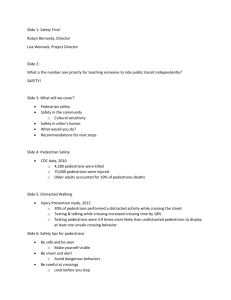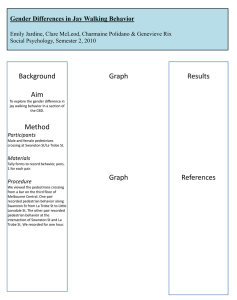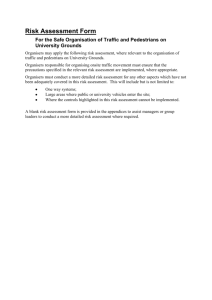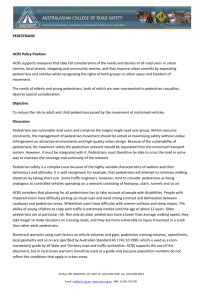Racial Bias in Driver Yielding Behavior at Crosswalks
advertisement
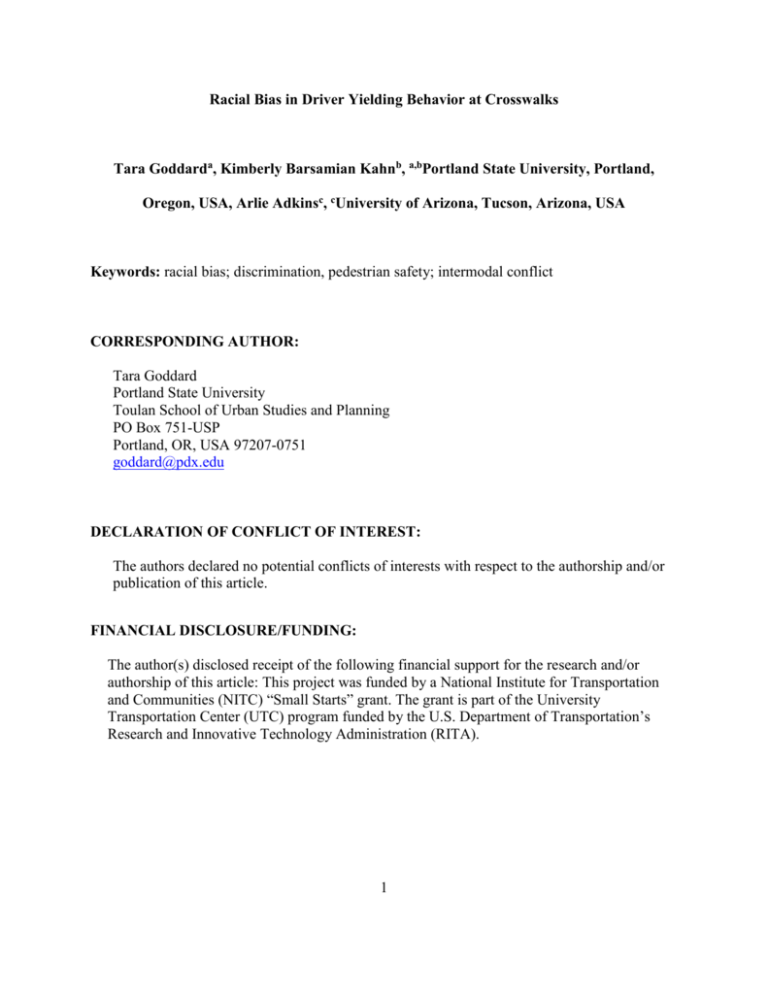
Racial Bias in Driver Yielding Behavior at Crosswalks Tara Goddarda, Kimberly Barsamian Kahnb, a,bPortland State University, Portland, Oregon, USA, Arlie Adkinsc, cUniversity of Arizona, Tucson, Arizona, USA Keywords: racial bias; discrimination, pedestrian safety; intermodal conflict CORRESPONDING AUTHOR: Tara Goddard Portland State University Toulan School of Urban Studies and Planning PO Box 751-USP Portland, OR, USA 97207-0751 goddard@pdx.edu DECLARATION OF CONFLICT OF INTEREST: The authors declared no potential conflicts of interests with respect to the authorship and/or publication of this article. FINANCIAL DISCLOSURE/FUNDING: The author(s) disclosed receipt of the following financial support for the research and/or authorship of this article: This project was funded by a National Institute for Transportation and Communities (NITC) “Small Starts” grant. The grant is part of the University Transportation Center (UTC) program funded by the U.S. Department of Transportation’s Research and Innovative Technology Administration (RITA). 1 Racial Bias in Driver Yielding Behavior at Crosswalks Abstract: Psychological and social identity-related factors have been shown to influence drivers’ behaviors toward pedestrians, but no previous studies have examined the potential for drivers’ racial bias to impact yielding behavior with pedestrians. If drivers’ yielding behavior results in differential behavior toward Black and White pedestrians, this may lead to disparate pedestrian crossing experiences based on race and potentially contribute to disproportionate safety outcomes for minorities. We tested the hypothesis that drivers’ yielding behavior is influenced by pedestrians’ race in a controlled field experiment at an unsignalized midblock marked crosswalk in downtown Portland, Oregon. Six trained male research team participants (3 White, 3 Black) simulated an individual pedestrian crossing, while trained observers cataloged the number of cars that passed and the time until a driver yielded. Results (88 pedestrian trials, 173 driver-subjects) revealed that Black pedestrians were passed by twice as many cars and experienced wait times that were 32% longer than White pedestrians. Results support the hypothesis that minority pedestrians experience discriminatory treatment by drivers at crosswalks. 2 1. Introduction Of the potential points of conflict present in our transportation systems, driver-pedestrian interactions at crosswalks involve the highest degree of vulnerability for pedestrians (NHTS, 2003). In order to safely cross at unsignalized crosswalks on busy roadways, pedestrians must wait until drivers yield, creating a scenario in which pedestrians’ experiences may depend in part on drivers’ subtle biases and attitudes influencing their decision whether or not to stop. One such bias that is present in many forms of interpersonal interactions, but which has so far not been tested in the context of driver behavior at crosswalks, is racial bias. Racial minorities are subjected to biased treatment and outcomes across a variety of societal domains, including education (Steele, 2010), employment (Pager, 2003; Schwartzman, 1997; Wilson, 1996), health care (Budrys, 2010; Dovidio, Penner, Albrecht, Norton, Gaertner, & Shelton, 2008), and criminal sentencing (Blair & Chapleau, 2004; Eberhardt, Davies, PurdieVaughns, & Johnson, 2006). Racially-biased behaviors are reflected in interpersonal interracial interactions, as subtle stereotypes influence individuals’ judgments and decisions (Dovidio, Kawakami, & Gaertner, 2002; Richeson & Shelton, 2007). There is ample evidence that racial minorities are treated differently and have different experiences within urban transportation systems. Racial disparities have been observed in hailing taxis (Ridley, Bayton, & Outtz, 1989), bargaining for new cars (Ayres & Siegelman, 1995), and being stopped by police for both drivers (Warren, Tomaskovic-Devey, Smith, Zingraff, & Mason, 2006) and pedestrians (Gelman, Fagan, & Kiss, 2007). There are also significant racial discrepancies in safety outcomes. From 2000 to 2010, the pedestrian fatality rates for Black and Hispanic men (3.93 and 3.73 per 100,000 population) were twice the rate for White men (1.78), even after controlling for increased exposure in urban areas, socioeconomic status, and alcohol use (CDC, 2013). 3 The social identity or physical characteristics of both drivers and pedestrians have been shown to influence yielding behavior at crosswalks. In one study in the United States, drivers yielded more frequently to research participants holding a “guide cane,” the white cane used by the blind or vision-impaired, than to pedestrians holding only an umbrella (Harrell, 1992). In an Israeli study, drivers were more likely to yield to pedestrians in their own age group (Rosenbloom, Nemrodov, & Ben, 2006). In another study conducted in the United States, drivers in expensive or high status vehicles were the least likely to yield to a pedestrian (Piff, Stancato, Mendoza-Denton, Keltner, & Coteb, 2012). These results suggest that drivers discern between different types of pedestrians and rapid decisions about yielding may be influenced by subtle attitudes and biases. Racially biased attitudes are present in individuals at both the explicit and implicit level. Explicit attitudes refer to attitudes that are consciously accessed and freely expressed (Smith & DeCoster, 2000). While explicit racial attitudes may contribute to racial disparities in treatment at crosswalks, explicit forms of racial bias have decreased over the last 50 years (Bobo, 1991). Contemporary forms of racial bias are often demonstrated on a covert or implicit level (Dovidio, 2001; Greenwald & Banaji, 1995; Greenwald, Poehlman, Uhlmann, & Banaji, 2009; Olson & Fazio, 2003). Implicit racial attitudes are subtle beliefs that individuals hold beneath their conscious awareness, but that can lead to discriminatory behavior and outcomes (Fazio & Olson, 2003). Pro-White, Anti-Black implicit attitudes are commonly held by a large percentage of Americans and have been shown to be a cause of discriminatory behaviors (Banaji & Greenwald, 2013; Baron & Banaji, 2006; Greenwald & Banaji, 1995; Joy-Gaba & Nosek, 2010; Nosek et al., 2007; Schmidt & Nosek, 2010). Implicit bias influences decisions that are difficult to monitor and control, and are particularly influential in fast-paced situations (Devine & Monteith, 1999; 4 Greenwald & Banaji, 1995; Greenwald, Poehlman, Uhlmann, & Banaji, 2009). In particular, implicit bias has been shown to affect split-second decisions regarding safety-related behavior, exposing racial minorities to more dangerous outcomes than racial majority group members (Kahn & Davies, 2011). The current study hypothesizes that drivers’ racial attitudes will impact their stopping behavior toward pedestrians. Although the current study does not provide a direct test of whether drivers’ implicit or explicit attitudes are the cause of this behavior, driving and stopping are representative of behaviors in which implicit attitudes are influential. Driving and stopping involve making fast-paced decisions, rife with distractions, and may be perceived as discretionary, which are conditions under which implicit attitudes are better predictors of behavior than explicit attitudes (Greenwald, Poehlman, Uhlmann, & Banaji, 2009). Differences in drivers’ yielding behavior at crosswalks for Black pedestrians would be an example of a daily microaggression that minorities consistently face. Microagressions are small and commonplace verbal, behavioral, or environmental experiences that indicate negative racial treatment (Hebl, Foster, Mannix, & Dovidio, 2002; Sue, Capodilupo, & Holder, 2008; Singletary & Hebl, 2009). Microagressions increase psychological and physiological signs of stress, and can negatively impact both physical and emotional well-being (Sue, Capodilupo, & Holder, 2008). Similar to other forms of microaggressions, the additive effect of small but repeated discriminatory treatment, and routine inconvenience such as additional delay at a crosswalk, can add up to significant burdens for racial minorities. In this paper, we present the findings of a controlled field experiment testing whether drivers’ stopping behavior varies depending on the race of the pedestrian attempting to cross the street. We hypothesize that, similar to other types of intergroup interactions, roadway interactions between drivers and pedestrians are likely influenced by drivers’ subtle racial 5 attitudes and biases. To test this hypothesis, we conducted a controlled field experiment in which we observed how drivers’ stopping behavior differed depending on whether it was a White or Black pedestrian (trained members of the research team) attempting to cross at a marked crosswalk. Results are based on analyses of whether the first approaching car stopped, how many cars passed before the participant could cross, and the total time a pedestrian had to wait before crossing. We hypothesized that drivers are less likely to stop for Black pedestrians than for White pedestrians crossing at a marked crosswalk and that Black pedestrians have longer wait times before they can safely cross. Differences in minority pedestrians’ experiences at crosswalks may lead to more delay, increased risk, and lower quality pedestrian experiences, dissuading them from choosing active transportation modes. These findings have implications for crosswalk design and may help inform efforts to promote equitable access to active transportation within minority communities. 2. Methods 2.1 Subjects and Design The field experiment was a one-way between-subjects design, with pedestrian race (Black vs. White) as the independent variable. Data were collected on 90 individual pedestrian crossing trials involving three White and three Black research participants. Pedestrians crossed the street using a marked crosswalk on a busy two-lane, one-way street in downtown Portland, Oregon. Each research participant pedestrian completed 15 crossing trials. These trials resulted in 173 driver subjects. 2.2 Location and time Trials were conducted over five days in September, October, and November 2013, with mild weather and clear conditions. All trials took place in off-peak hours of the morning and 6 afternoon, under free-flow traffic conditions (i.e. no stop-and-go or congested traffic). Trials were initiated when no other pedestrians were present. If additional pedestrians arrived at the crosswalk while a trial was underway, data collection continued but these trials were excluded from the current analysis. In the final analysis, two trials were removed due to missing data. Final trials included for analysis were evenly distributed by time of day and individual field session, which always involved alternating trials with Black and White pedestrians. The pattern of results did not differ based on crossing session, so data from all sessions was combined. The field experiment was conducted at an unsignalized midblock crosswalk in downtown Portland, Oregon. Portland is a city of approximately 600,000 people in the Pacific Northwest region of the United States. According to the 2010 United States Census, Portland is 76.1% White and 6.3% Black or African American (U.S. Census 2010). Downtown Portland has short block lengths and is laid out in the grid pattern typical of urban downtowns. The study crosswalk is marked with the common “zebra” pattern and connects two of the Portland “park blocks” at midblock. This area is a busy pedestrian environment near Portland State University, where drivers frequently encounter pedestrians of different races during daytime hours. Pilot testing confirmed that sight distances at the crosswalk allowed drivers to see the waiting pedestrians with sufficient time to stop. Traffic travels one-way from east to west in two lanes at the study location. Using a midblock crossing reduced the complication of turning movements affecting drivers’ propensity to stop for pedestrians and reduced ambiguity about whether a driver was slowing to yield for the pedestrian or to make a turn. 2.3 Experimental Procedure Three White and three Black research participants were recruited to participate in the study as the crossing pedestrians. All six were men in their 20s, and were matched based on their 7 height and build. Each research participant was clearly identified as either White or Black and was phenotypically representative of their racial group (Eberhardt at el., 2006; Kahn & Davies, 2011). As is commonly done in racial bias research, in order to isolate the effect of race, participant pedestrians wore an identical outfit of long-sleeve gray shirt and khaki pants to achieve a neutrally-colored palette that did not indicate any obvious socio-economic status or social characteristics. Participants were trained in walking speed, body posture, and safety protocols in an earlier field session so that they approached and crossed the crosswalk in an identical manner. Having all participants using the same walking speed and body posture helped control for any differences in our pedestrians’ behavior that might affect drivers’ decision to yield. The field experiment utilized several trained coders and observers. Two trained observers stood approximately 30 feet from the crosswalk (out of sight of oncoming cars) and recorded whether the first car to approach yielded to the pedestrian, how many cars passed by before a driver yielded, and how many seconds elapsed before each pedestrian was able to cross (from time the pedestrian stepped up to edge of the curb until when the driver yielded to the pedestrian to cross). Inter rater reliability ranged from 0.9 to 1.0 on all measures. The pedestrians waited as a group out of sight of the cars and approached the crosswalk one at a time when instructed by a research team member. Black and White pedestrians alternated in their individual street crossings. By alternating Black and White pedestrian crossings, extraneous variables, such as driver identities, weather conditions, and traffic flow are randomly distributed between the Black and White crossings. Trials did not begin until there were cars waiting at the upstream traffic signal to ensure the presence of driver-subjects for a trial. A trial was initiated after the upstream traffic signal turned green and the first car crossed 8 the near side crosswalk approximately 300 feet away, which ensured that traffic was flowing and the trials were not affected by drivers failing to notice the green signal. Use of a downtown location with upstream signalized blocks helped ensure fairly consistent traffic volumes and speeds, and the alternating crossings by pedestrian race also controls for slight variations in traffic. Participants were cued so that they arrived at the crosswalk at the same time in each trial. Timing started when the pedestrian arrived at the crosswalk and indicated their intention to cross. Participants indicated their intention to cross by stepping up to the curb, positioning their body slightly toward oncoming traffic, making eye contact if possible, and remaining on the curb until a driver clearly yielded. Oregon law requires drivers to stop only if a pedestrian has stepped into the street in a marked or unmarked crosswalk. Our experiment, therefore, did not test compliance with the law, but rather the extension of courtesy to pedestrians who were clearly waiting to cross the street but had not yet entered the roadway. This reflects previous research that found evidence that drivers consider yielding a discretionary choice (e.g. Piff et al, 2012; Rosenbloom et al, 2006). It is also more likely that racial bias is observed in these discretionary actions (e.g., Gaertner & Dovidio, 1986), such as deciding whether to yield to a pedestrian who is clearly waiting to cross the street. Once a car had clearly yielded or stopped for the pedestrian, the trial timing stopped and the pedestrian crossed the street at a normal walking pace. When the pedestrian reached the other side of the road, the trial ended. There was approximately a one- to two-minute break before the next pedestrian was cued to approach the crosswalk and begin the subsequent trial. Differences between driver stopping behaviors toward Black and White pedestrians were examined for three variables of interest: number of cars that passed without yielding, elapsed time before pedestrian could cross, and a dichotomous variable indicating whether the first 9 approaching car stopped for our pedestrian waiting at the curb. Differences between Black and White pedestrians were tested using one way ANOVA for number of cars and time until yield, and chi-square test for the first car stopping. 3. Results A total of 173 driver subjects passed through the crosswalk during the 88 included trials. The first approaching car stopped in roughly half (n=46, 52.3%) of the trials. The average number of cars to pass without yielding was 1.49 (SD=2.07), and the average wait until a car yielded was 8.57 seconds (SD=4.97). Significant differences between Black and White participants were found for two of the three measures (Table 1). The average of 2.02 drivers (SD=2.39) that passed Black pedestrians without stopping was more than twice the average of .98 drivers (SD=1.56) who passed White pedestrians without stopping. The “time until yield” measure varied significantly by pedestrian race, with an average wait time for Black pedestrians that was 32% longer than for White pedestrians. Table 1: Differences in numbers of cars passing before yielding and time until first car yielded by race Total Black White Difference Average SD Average SD Average SD F p Cars passing 1.49 2.07 2.02 2.39 0.98 1.56 5.95 0.017 Time (seconds) 8.57 4.97 9.79 5.67 7.4 3.93 5.31 0.024 A chi-squared test indicated that whether the first car stopped did not differ significantly by pedestrian race, χ2=.398, p=.528, with 55.6% of first cars stopping for White pedestrians and 48.8% stopping for Black pedestrians. Black pedestrians were, however, more than twice as likely as White pedestrians (45.2% versus 22.2%) to have to wait for two or more cars, χ² = 5.18, p. = .02 (Figure 1). 10 Figure 1. Yielding behavior by pedestrian race depending on whether first car stops 4. Discussion In this controlled field experiment, more drivers passed by and did not stop for Black pedestrians than for White pedestrians who were waiting to cross the street at a crosswalk. Correspondingly, Black pedestrians experienced longer wait times before they could cross the street safely. The controlled experimental methodology used in the field experiment indicates the causal nature of pedestrian race on drivers’ stopping behavior. While the overall difference in wait times may appear small on the surface, the cumulative differences grow in magnitude if these longer wait times are projected across multiple street crossings on an average walk. Because this was a naturalistic field experiment in which drivers were not intercepted or tested directly, we are not able to make conclusions about the source of the racial bias of drivers. It is possible that drivers were consciously, overtly, and explicitly racially biased in their stopping decisions, deliberately deciding to not stop for Black pedestrians. Our findings, 11 however, are consistent with behavioral manifestations of implicit racial attitudes (Greenwald, Poehlman, Uhlmann, & Banaji, 2009; Nosek, Greenwald, & Banaji, 2005). Implicit attitudes are more predictive of behavior when situations necessitate quick decision making, distractions are present, and anonymity is increased (Greenwald & Banaji, 1995; Greenwald, Poehlman, Uhlmann, & Banaji, 2009; Kahn & Davies, 2011), as exists when driving on a busy street. Because implicit racial bias against Blacks is a commonly held attitude (Greenwald, Nosek, & Banaji, 2003), drivers’ implicit racial attitudes might explain the biased stopping behavior as they make quick decisions while scanning the road and evaluating multiple stimuli. Also characteristic of implicit bias, drivers may not be aware of the bias in their stopping decisions. The lack of awareness of implicit racial bias allows these biases to magnify and persist. Future research should further test the role of implicit or explicit racial attitudes on driver’s stopping decisions using other methodologies, including naturalistic methods and driving simulators, when both types of attitudes can be examined. Illuminating the psychological processes through which drivers make these biased stopping decisions could inform potential intervention routes. Consistent with racial bias in other domains, one novel result of this study was the disparity in driver stopping behavior between White and Black participants if the first driver did not stop. A possible explanation for this finding that subsequent drivers were more likely to pass Black participants, resulting in longer wait times, may result from drivers observing and replicating the anti-social behavior of drivers before them. That is, they may observe other drivers not stopping for Black pedestrians and use this evidence to inform or even justify their decisions to not stop. This pattern is consistent with the Focus Theory of Normative Conduct, which states that people are more likely to perform an anti-social behavior if their focus is drawn to a normative example of that anti-social behavior (Cialdini, Reno, & Kallgren, 1990). Drivers 12 may feel that it is more acceptable to enact the antinormative behavior of not stopping for pedestrians if they see others not stop first. However, they may not replicate this anti-normative behavior for White pedestrians, and only express it with Black pedestrians due to racial bias. Further investigation in the future of the role of descriptive social norms could be used to more fully understand the role of normative conduct in driver yielding behavior by pedestrian race. 4. Limitations and Future Research There are several limitations to be considered along with our findings. First, the experiment was conducted in one location, compared only two racial groups, and only tested male pedestrians, so generalizations to other cities, other racial minorities, or by gender are not possible. Future research should explore differences in driver yielding in these other contexts. Second, as previously acknowledged, we were not able to test whether differences in crossing could be attributed to implicit or explicit racial bias. Another limitation is that we did not test the legal right of way trigger of a pedestrian stepping off the curb so we cannot say if the racial bias we observed would persist when drivers became legally obligated to stop. This is another area for future research, but does not discount our findings related to racial disparities in drivers stopping for pedestrians waiting to cross the street. And finally, we acknowledge that by dressing participants in identical neutral clothing and training them to act the same, we were controlling for characteristics that are potentially symbols of both racial identity and socio-economic status. Further research could test the degree to which stereotypically racialized clothing moderates the effect of skin color. The role of racial bias in drivers’ behavior toward other road users is an area of inquiry where further research is needed, because it may have implications for safety and the adoption of healthier, more environmentally-friendly modes. 13 6. Conclusion This paper demonstrates that drivers exhibited racial bias when making decisions about whether or not to stop for pedestrians waiting to cross the street at a marked crosswalk. Although it may seem small, the observed disparity may contribute to the myriad small inconveniences and indignities faced by minorities known as microaggressions. Our finding of racial bias consistent with microaggressions has implications for transportation officials working to increase participation in active transportation modes, as the additive effect of these repeated negative experiences while crossing may deter minorities from choosing to walk, and may contribute to the danger pedestrians face at street crossings. Changing drivers’ racial biases, particularly implicit ones, is a difficult task. Further research is needed to test the contribution of raciallybiased yielding behaviors to safety and the pedestrian experience, and the degree to which signage and design features that make stopping appear less discretionary could mitigate the effects of racial bias. 14 7. References: Banaji, M. R., & Greenwald, A. G. (2013). Blindspot: Hidden biases of good people. Random House LLC. Baron, A. S., & Banaji, M. R. (2006). The development of implicit attitudes: Evidence of race evaluations from ages 6 to 10 and adulthood. Psychological Science, 17, 53-58. Blair, I.V., Judd, C. M., & Chapleau, K.M. (2004a). The influence of Afrocentric facial features in criminal sentencing. Psychological Science, 15, 674-679. Bobo, L. (2001). Racial attitudes and relations at the close of the twentieth century. In N. J. Smelser, W. J.Wilson, & F. Mitchell (Eds.), Racial trends and their consequences, Vol. 1 (pp. 264–301). Washington, DC: National Academy Press. Budrys, G. (2010). Unequal health: How inequality contributes to health or illness. Lanham, MD: Rowman & Littlefield Publishers, Inc. Cialdini, R. B., Reno, R. R., & Kallgren, C. A. (1990). A focus theory of normative conduct: Recycling the concept of norms to reduce littering in public places. Journal of Personality and Social Psychology, 58, 6, 1015-1026. Devine, P.G., & Monteith, M.J. (1999) Automaticity and control in stereotyping. In Chaiken, S., & Trope, Y. (Eds.).Dual-process theories in social psychology. Guilford Press. Dovidio, J. F. (2001). On the Nature of Contemporary Prejudice: The Third Wave. Journal of Social Issues, 57, 4, 829-849. Dovidio, J. F., Kawakami, K., & Gaertner, S. L. (2002). Implicit and explicit prejudice and interracial interaction. Journal of Personality and Social Psychology, 82, 62-68. Dovidio, J. F., Penner, L. A., Albrecht, T. L., Norton, W. E., Gaertner, S. L., & Shelton, J. N. (2008). Disparities and distrust: the implications of psychological processes for understanding racial disparities in health and health care. Social Science & Medicine, 67, 478-486. Eberhardt, J.L., Davies, P.G., Purdie-Vaughns, V.J., & Johnson, S.L. (2006). Looking deathworthy: Perceived stereotypicality of Black defendants predicts capital-sentencing outcomes. Psychological Science, 17, 383-386. Gaertner, S. L., & Dovidio, J. F. (1986). The aversive form of racism. Academic Press. Greenwald, A. G., & Banaji, M. R. (1995). Implicit social cognition: attitudes, self-esteem, and stereotypes. Psychological Review, 102, 1, 4-27. Greenwald, A. G., Nosek, B. A., & Banaji, M. R. (2003). Understanding and using the implicit association test: I. An improved scoring algorithm. Journal of Personality and Social Psychology, 85, 2, 197-216. Greenwald, A. G., Poehlman, T. A., Uhlmann, E. L., & Banaji, M. R. (2009). Understanding and using the Implicit Association Test: III. Meta-analysis of predictive validity. Journal of Personality and Social Psychology, 97, 1, 17-41. Harrell, W. A. (1992). Driver Response to a Disabled Pedestrian Using a Dangerous Crosswalk. Journal of Environmental Psychology, 12, 4, 345. Harrell, W. A. (1993). The Impact of Pedestrian Visibility and Assertiveness on Motorist Yielding. Journal of Social Psychology, 133, 3.) 15 Hebl, M. R., Foster, J. B., Mannix, L. M., & Dovidio, J. F. (2002). Formal and Interpersonal Discrimination: A Field Study of Bias Toward Homosexual Applicants. Personality and Social Psychology Bulletin, 28, 6, 815-825. Huybers, S., Van, H. R., & Malenfant, J. E. (2004). Reducing conflicts between motor vehicles and pedestrians: The separate and combined effects of pavement markings and a sign prompt. Journal of Applied Behavior Analysis, 37, 4, 445-56. Joy-Gaba, J. A., & Nosek, B. A. (2010). The surprisingly limited malleability of implicit racial evaluations. Social Psychology, 41, 137-146. Kahn, K., & Davies, P. (2011). Differentially dangerous? Phenotypic racial stereotypicality increases implicit bias among ingroup and outgroup members. Group Processes and Intergroup Relations, 14, 4, 569-580. National Highway Traffic Safety Administration. (2003). Pedestrian roadway fatalities. Annals of Emergency Medicine, 42, 4, 479-80. National Highway Traffic Safety Administration. (2009). Traffic safety facts, 2006 data: race and ethnicity. Washington, DC. Available at http://wwwnrd.nhtsa.dot.gov/pubs/810995.pdf Nosek, B. A., Smyth, F. L., Hansen, J. J., Devos, T., Lindner, N. M., Ranganath, K. A., & Banaji, M. R. (2007). Pervasiveness and correlates of implicit attitudes and stereotypes. European Review of Social Psychology, 18, 36-88. Nosek, B. A., Greenwald, A. G., & Banaji, M. R. (2005). Understanding and using the Implicit Association Test: II. Method variables and construct validity. Personality & Social Psychology Bulletin, 31, 2, 166-80. Olson, M. A., & Fazio, R. H. (2003). Relations between implicit measures of prejudice: What are we measuring? Psychological Science, 14, 6, 636-639. Pager, D. (2003). The Mark of a Criminal Record. American Journal of Sociology, 108, 937– 975. Piff, P. K., Stancato, D. M., Mendoza-Denton, R., Keltner, D., & Coteb, S. (2012). Higher social class predicts increased unethical behavior. Proceedings of the National Academy of Sciences of the United States of America, 109, 11, 4086-4091. Project Implicit. Retrieved September 2, 2013 from www.projectimplicit.net Richeson, J. A., & Shelton, J. N. (2007). Negotiating interracial interactions costs, consequences, and possibilities. Current Directions in Psychological Science, 16, 316-320. Rosenbloom, T., Nemrodov, D., & Ben, E. A. (2006). Yielding behavior of Israeli drivers: interaction of age and sex. Perceptual and Motor Skills, 103, 2, 387-90. Schmidt, K., & Nosek, B. A. (2010). Implicit (and explicit) racial attitudes barely changed during Barack Obama’s presidential campaign and early presidency. Journal of Experimental Social Psychology, 46, 308-314. Schwartzman, D. (1997). Black male unemployment. The Review of Black Political Economy, 25, 77–93. Singletary, S. L., & Hebl, M. R. (2009). Compensatory strategies for reducing interpersonal discrimination: the effectiveness of acknowledgments, increased positivity, and individuating information. The Journal of Applied Psychology, 94, 3, 797-805. Smith, E. R., & DeCoster, J. (2000). Dual-process models in social and cognitive psychology: Conceptual integration and links to underlying memory systems. Personality and Social Psychology Review, 4, 108-131. 16 Steele, C. M. (2010). Whistling Vivaldi and other clues to how stereotypes affect us. NewYork: W. W. Norton & Company. Sue, D. W., Capodilupo, C. M., & Holder, A. (2008). Racial microaggressions in the life experience of Black Americans. Professional Psychology: Research and Practice, 39, 329. Surface Transportation Policy Partnership (2002). Mean Streets 2002.Washington, DC. Available at http://www.transact.org/PDFs/ms2002/MeanStreets2002.pdf. U.S. Census Bureau: State and County QuickFacts. Data derived from Population Estimates, American Community Survey, Census of Population and Housing, County Business Patterns, Economic Census, Survey of Business Owners, Building Permits, Census of Governments Wilson, W. J. (1996). When work disappears: The world of the new urban poor. New York: Alfred Knopf. Zegeer, C. V., United States., University of North Carolina & Turner-Fairbank Highway Research Center. (2005). Safety effects of marked versus unmarked crosswalks at uncontrolled locations: Final report and recommended guidelines. McLean, VA: U. S. Department of Transportation, Federal Highway Administration, Research, Development, and Technology, Turner-Fairbank Highway Research Center. 17
